Photo Orangeburg Times and Democrat
It is unfortunate that predominantly black Orangeburg South Carolina’s only footnote in history is to be known as the site of a 1968 “massacre” in which 3 people were shot to death by state law enforcement officers.
The Events of February 6-8 1968
It began when a group of three dozen students from State College's Lowman Hall marched to All Star Bowling Lanes on February 6, 1968, in hopes of persuading the owner to let black students bowl.
The alley had been closed that day on orders of the city police chief. When the students returned the next day February 7, the bowling alley was surrounded by police toting nightsticks. A group of blacks were allowed into the bowling alley where they were promptly arrested for trespassing.
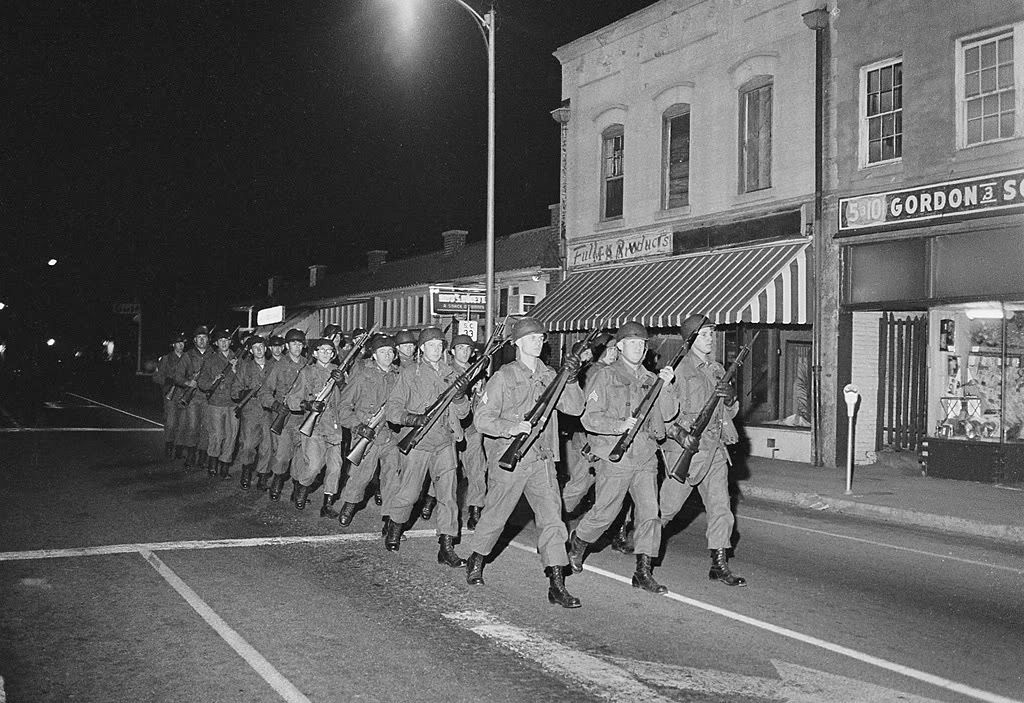
National Guard Troops in Orangeburg, South Carolina
News of the arrest made its way back to campus and before long an angry throng began challenging police around All Star Bowling Lanes. A skirmish started when a store window was smashed and the police reacted, swinging batons and firing tear gas.
Students smashed windows and set fires to area buildings, causing about $5,000 worth of damage. By this time several black students had been beaten, a few of them were hospitalized in the wake of the rioting, and at one point there was gunfire from the direction of Claflin College, where someone fired over the heads of patrolmen.
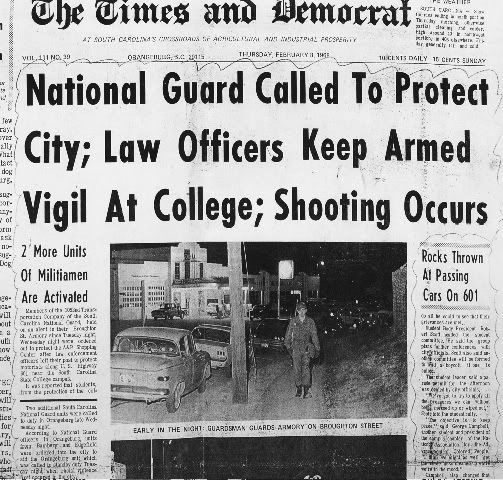
February 8, 1968 - It was a cool clear night when a group of state policemen armed with riot guns gathered at the gates of South Carolina State College. They were authorized to fire their guns at their own discretion, additionally their riot shotguns were loaded with buckshot pellets instead of bird shot which had been the standard issued rounds for riot control.
A mixture of fear and tension lingered in the air. At the edge of the campus, students participated in a civil rights demonstration around a bonfire, soon tempers flared, obscenities were shouted as police and firemen attemped to put out the fire.
At some point students began to throw debris at the police officers. The situation escalated when one officer was hit in the face with a large piece of what has been described as part of a bannister. As the officer lay bloodied on the ground no doubt the state police were mindful of recent events throughout the country were rioting protesters had beaten and killed several police officers.
The darkness, was filled with smoke, confusion, taunts and hatred reverberated from all directions when sometime after 9PM an unidentified patrolman raised his gun in the air and fired several shots without warning over the crowd to settle them down. Suddenly more shots rang out, continuing for 10 seconds or less, as the demonstrators scrambled for safety students 30 were struck by the gun fire and Henry Smith, Samuel Hammond and Delano Middleton were killed.
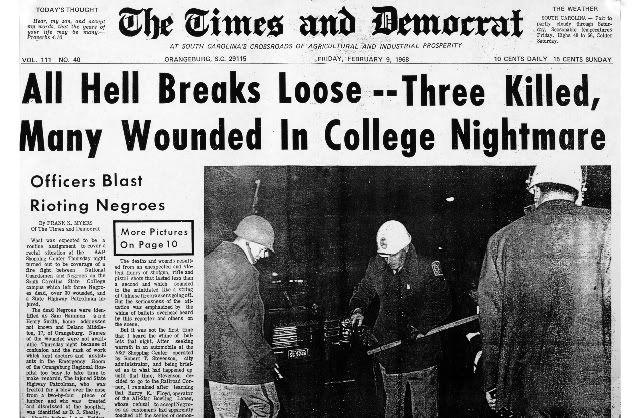
But the events of February 6-8 were hardly reported outside of the local press. Many felt that the American Public had turned their backs on the civil rights movement after 3 years of riots and protests.
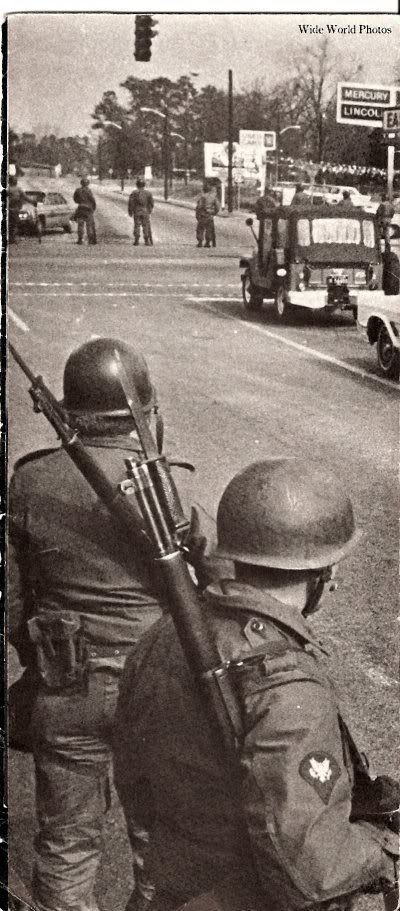
Orangeburg became well known, not for the attack on black student protesters but for the little or no media coverage the shootings received at the time and the related lack of acceptance of the 3 victims as martyrs.
Blame for the lack of coverage and public outcry has been directed at country's view of African Americans as sub human at the time, in the following months Dr. King and Robert Kennedy would also fall to gun fire, and the struggles of young black Americans at a rural South Carolina College would evaporate like summer rain on endless rows of cotton fields.
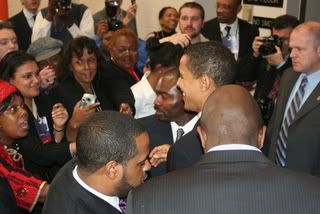
President Barack Obama in Orangeburg 2007 Photo by the author
Yet racial divide continues even today in a place where black and white live in apparent harmony.
Case in point was the second political rally in South Carolina for presidential candidate Barack Obama in February 2007 during which 99% of the attendees where black though 38% of the area's democrats are white.
Washington Post Coverage of Barck
Obama's February 2007 visit to Orangeburg
To understand part of reason for the lack of media coverage in 1968 it is important to know the media at the time, while the large newspapers across the country were controlled by white owners in 1968, the country had more black newspapers that chilly February night than it does today.
Live television was still a new concept as satellite technology was a quirky combination of electronics and luck, which required equipment that was massive and hardly mobile.
I-26 was nothing more than a promise from Washington and the road to Columbia was a two lane hilly ride at 50 miles per hour.
The later Federal Trial of 9 police officers and their eventual acquittal, garnered little media attention as compared to the four police officers who were found not guility in 1992 of using excessive force in the beating of motorist Rodney King. The media coverage that followed the LAPD trial sparked the 3 days of riots in Los Angeles.
1992 LA Riots black and white police officers hold two white suspects at gun point.
Over the years there have been many notable “massacres” in our country, some of which received attention, others were simply brushed aside.
Prior to 1968 mass protests were often met by brutal police or military force but only a handful are noted in the history books.
The Boston Massacre involved the deaths of five civilians at the hands of British troops on March 5, 1770, the aftermath which sparked the rebellion of the British colonies in America which culminated in the American Revolution.
The New York Draft Riots (July 13 to July 16, 1863 were a series of violent disturbances in New York City that were the culmination of discontent with new laws passed by Congress to draft men to fight in the ongoing American Civil War. The governments response was to dispatch several regiments of militia and volunteer troops to control the city. In the end more than 100 protesters were killed and as many as 300 wounded.
The Herrin Massacre occurred in June of 1922 in Herrin, Illinois. 20 strikebreakers and 3 union miners were killed in mob action between June 21-22, 1922.
Two years after Orangeburg, on May 4, 1970 Kent State would become a name cemented in history as the site of another "massacre" yet today is known mostly as a tragedy that is normally marked with a small gathering and little media attention.
The Jackson State killings occurred on May 14-15, 1970, at Jackson State College in Jackson, Mississippi. A group of student protesters were confronted by city and state police. The police opened fire, killing two students and injuring twelve. But today Jackson State is little more than a polite footnote to the Kent State shooting that occured ten days prior.
Of the recent shootings only Kent State has received large national media attention. Due largely in part to John Filo's iconic Pulitzer Prize-winning photograph of Mary Ann Vecchio, a fourteen-year-old runaway, kneeling over the dead body of Jeffrey Miller after he was shot by the Ohio National Guard.
It is the media that feeds the fire that stirs emotions that lead to political change or unrest. The expected coverage of the reenactment in Orangeburg, South Carolina will undoubtedly encourage not, remembrance, change or enlightenment, but bitterness, unrest and anger within the black community.
Photo Orangeburg Times and Democrat
Some things shouldn't be reenacted as much as remembered for in the death of the young we have lost the promise of an untold future.

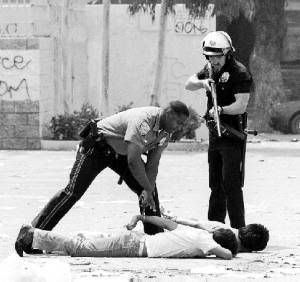
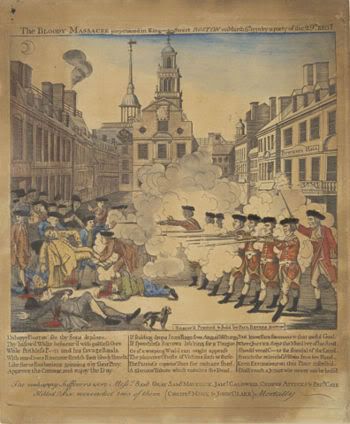
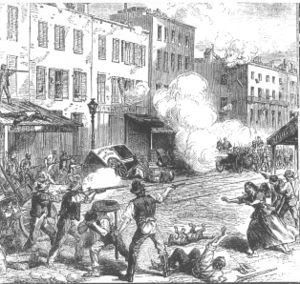


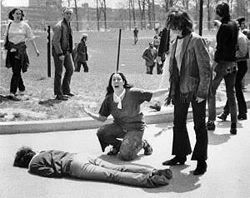
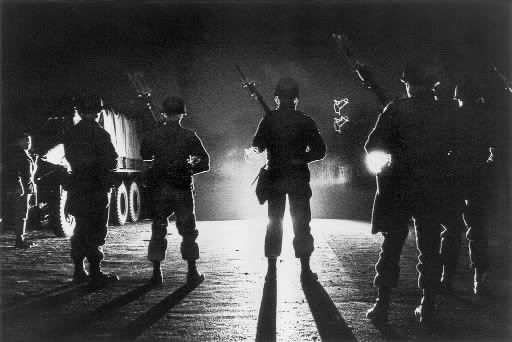
No comments:
Post a Comment